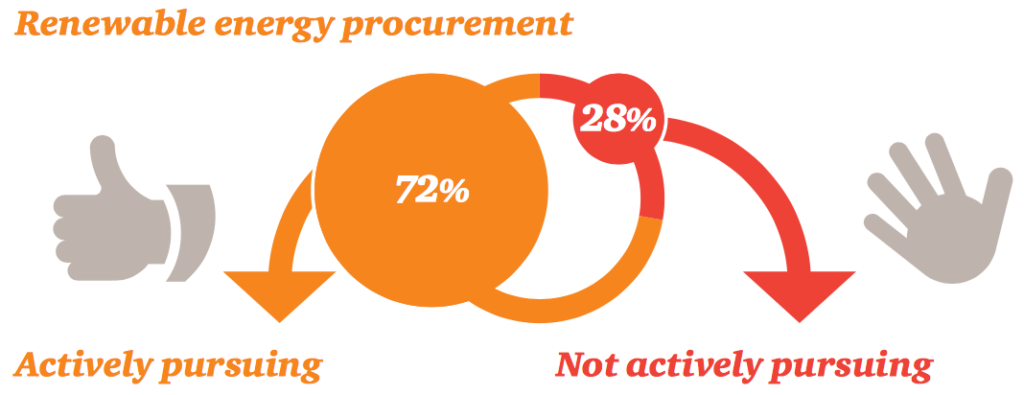
The Fast Track to Corporate Renewables
Amy Hou | June 28, 2018 | Energy & Sustainability
Zero to 100 isn’t always the most realistic path to a clean energy goal. Setting and meeting milestones along the way gives the global economy time to stay on track. Fortunately, Bloomberg NEF’s New Energy Outlook 2018 report models a bright future for renewables, predicting that wind and solar generation will reach “50 by 50”: 50 percent of world energy production by the year 2050. Still, businesses will have to do their part to help get us there, and that starts with building up their renewable energy portfolios.
A Profile of Renewables Purchases
PwC surveyed directors responsible for energy procurement at some of the largest companies headquartered in the U.S. and found that, overall, interest in renewables is high. 71 percent of respondents have purchased renewables in the past; 72 percent are actively pursuing purchases now, and 85 percent of past purchasers intend to add more to their renewable energy portfolios within the next 18 months.
That’s not to say, however, that the renewable energy procurement process is all smooth sailing. Respondents said building internal support for investments is the biggest hurdle they face. Then, once renewables have been purchased, tracking the savings and developing a business case for future projects remain the toughest ongoing challenges.
Related >> Gaining Sustainability Buy-In with Utility Data
Data Gives Renewable Energy Portfolios a Boost
Setting off on renewable energy procurement is a good start, but energy procurement managers won’t reach the finish line unless they can prove the ROI on existing projects. And proving ROI requires data. The data needed for energy procurement includes:
- Historical data on energy usage and cost
- Analysis of location-based tariffs and rates
- Ongoing tracking of cost savings
- Ongoing tracking of reduced reliance on fossil fuels
Once this data is on hand, businesses can easily identify how much they save on each project and, going forward, make the case for expanding their renewable energy portfolios.
As Keith Mask, VP of Environmental Sustainability at Cox Enterprises, said: “Renewable energy projects like solar are a key component of the Cox Conserves program, helping us offset more than 102,360 tons of carbon since 2007. Urjanet Utility Data has been a critical tool to pinpoint the highest priority sites for installation and to see the impact of our investments year over year.”
Related >> Cox Enterprises Cuts Energy Spend with Urjanet Utility Data
As we move toward a 100 percent clean energy future, it’s heartening to see that businesses are already doing their part to shape the renewables sector. With accurate and comprehensive data, they can continue to boost their renewable energy portfolios and pave the way for their peers to follow.
Check out our solutions sheet to learn more about accessing utility data for energy procurement.
You may also like:
- A Day in the Life: Energy Procurement
- The Road to 100 Percent Renewable Energy
- Kroger Takes Out the Trash — And the Competition
If you like what you’re reading, why not subscribe?
About Amy Hou
Amy Hou is a Marketing Manager at Urjanet, overseeing content and communications. She enjoys writing about the latest industry updates in sustainability, energy efficiency, and data innovation.
You May Also Like
Support Business Continuity by Embracing ESG
Honor Donnie | March 18, 2022 | Energy & Sustainability

